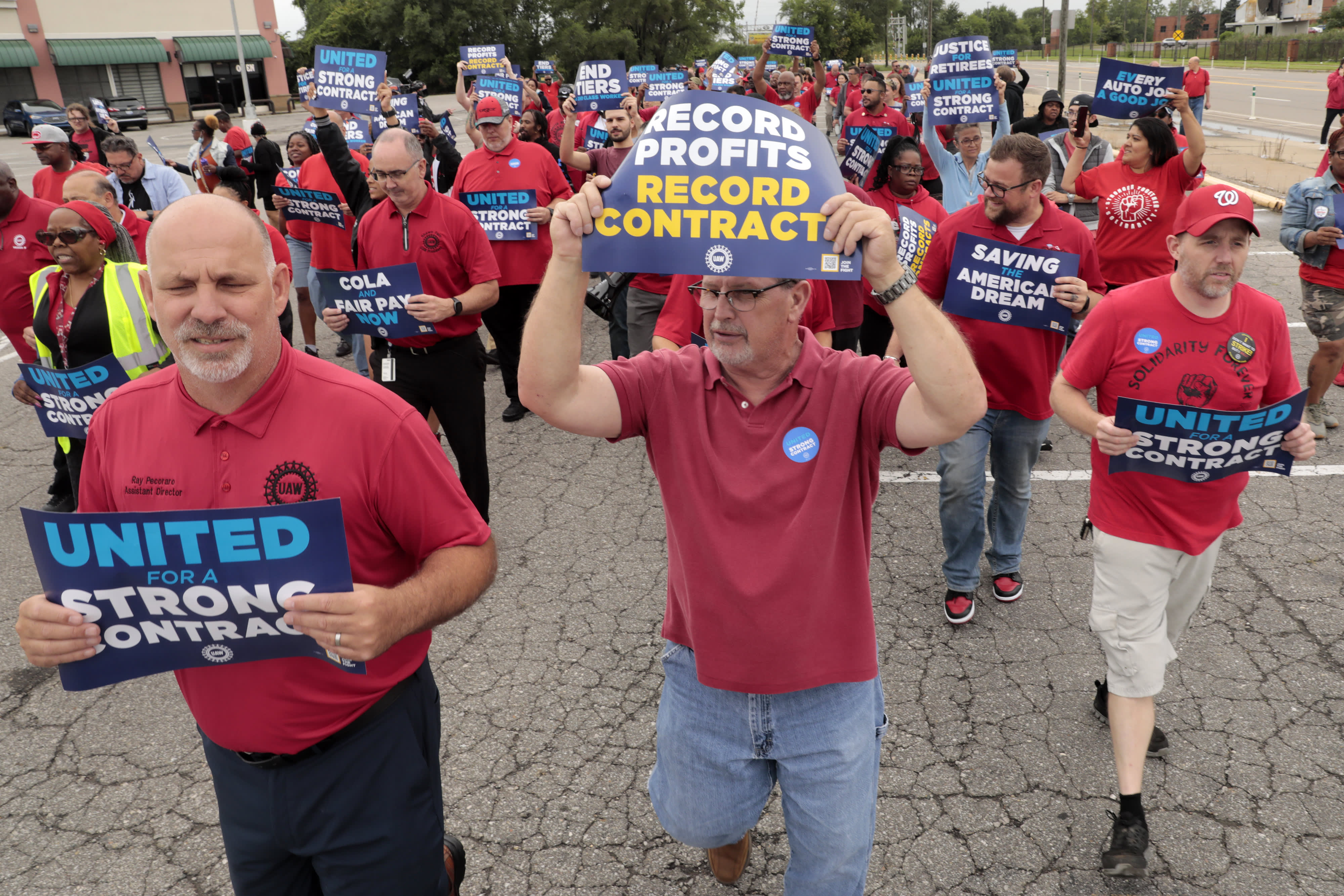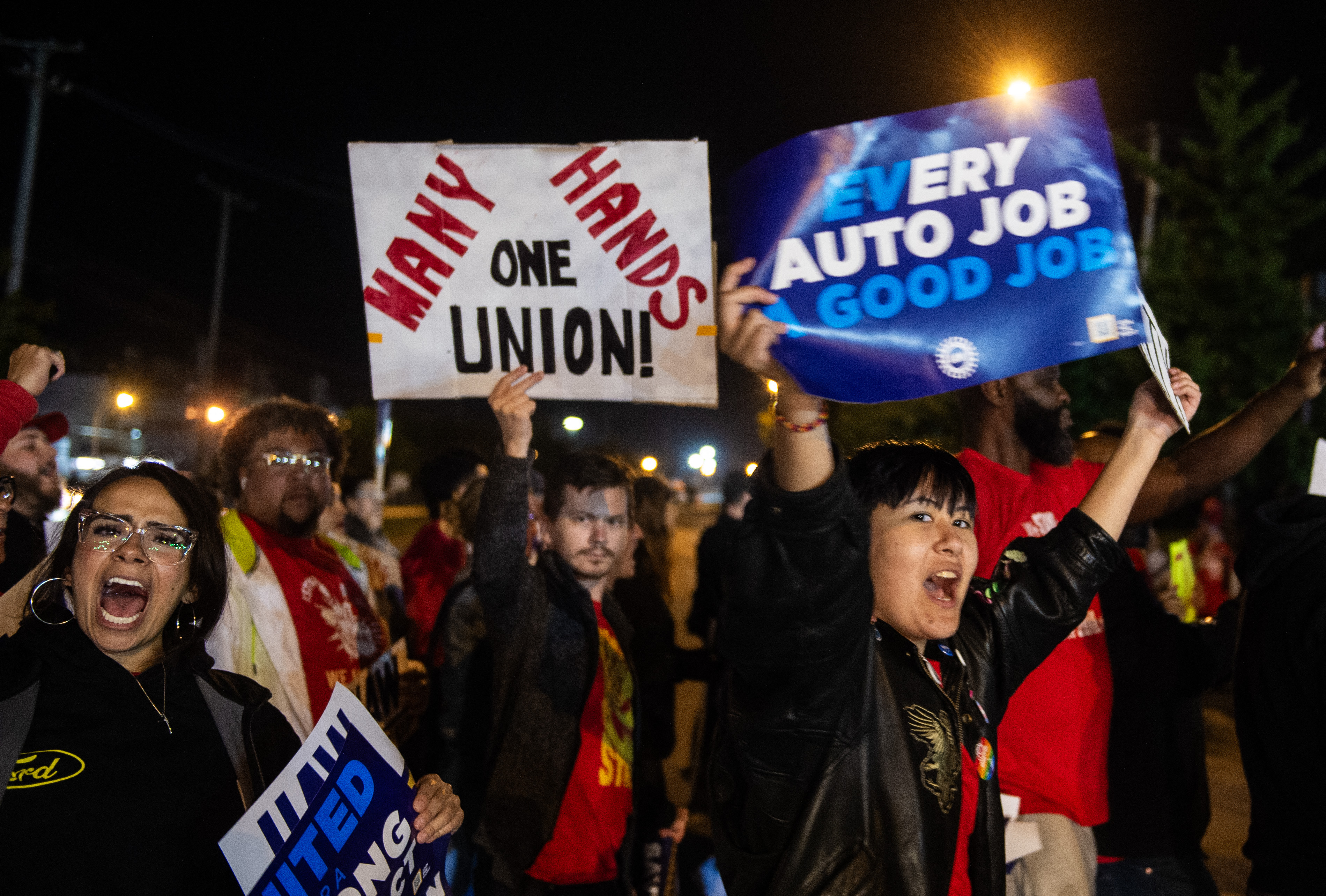President Joe Biden announced Friday his administration is sending top aides to Detroit to help with the contract negotiations between United Auto Workers and the three major automakers, saying employers should share profits with unionized workers.
"Those record profits have not been shared fairly, in my view, with those workers," Biden said.
In brief remarks from the White House, Biden said auto workers "deserve a contract that sustains them and the middle class."
"No one wants a strike. But I respect the workers' right to use their options under the collective bargaining system. And I understand the workers' frustration," the president said.
We've got the news you need to know to start your day. Sign up for the First & 4Most morning newsletter — delivered to your inbox daily. Sign up here.
Biden also announced that he's sending acting Labor Secretary Julie Su and White House adviser Gene Sperling to Detroit to help the two parties reach a contract agreement.
About 13,000 U.S. auto workers stopped making vehicles and went on strike Friday after their leaders couldn’t bridge a giant gap between union demands in contract talks and what Detroit’s three automakers are willing to pay.
Members of the United Auto Workers union began picketing at a General Motors assembly plant in Wentzville, Missouri; a Ford factory in Wayne, Michigan, near Detroit; and a Stellantis Jeep plant in Toledo, Ohio.
It is the first time in the union’s 88-year history that all three companies were targeted simultaneously.
The strikes will likely chart the future of the union and of America’s homegrown auto industry at a time when U.S. labor is flexing its might and the companies face a historic transition from building internal combustion automobiles to making electric vehicles.
If the strikes drag on, shortages could push vehicle prices higher and strain an economy already bruised by inflation. Walkouts may even become a factor in next year’s presidential election, testing Biden’s claim to be the most union-friendly president in American history.
“Workers all over the world are watching this,” said Liz Shuler, president of the AFL-CIO, a federation of 60 unions with 12.5 million members.
The union’s tactics have changed. While the UAW is striking all three automakers, led by its pugnacious new president, Shawn Fain, not all of the 146,000 UAW members at company plants are walking picket lines, at least not yet.
The UAW targeted a handful of factories this time in a bid to get automakers closer to the union’s demand of 36% wage increases over four years. GM and Ford offered 20% and Stellantis, formerly Fiat Chrysler, offered 17.5%.
The limited strikes will stretch the union’s $825 million strike fund, which would run dry in about 11 weeks if all workers walked out. Strikes at other plants may begin if automakers don't budge, Fain said.
Carlos Guajardo, who has worked at Ford for the past 35 years and was employed by GM for 11 years before that, said he likes the new strategy of simultaneous, yet targeted, strikes.
“It keeps the strike fund lasting longer,” said Guajardo, who was out on the picket line before the sun came up.
The limited-strike strategy could have ripple effects, GM CEO Mary Barra said in a Friday interview on CNBC.
“A lot of our assembly plants also have contiguous stamping plants that may serve other plants," Barra said. We’ve worked to have a very efficient manufacturing network, so yes, even one plant is going to start to have impact.”
Britney Johnson, 35, who has worked for the company about 3 1/2 years, joined about 400 workers on the picket line outside the Ford plant in suburban Detroit.
“I like the job," she said. “It’s just that we deserve more.”
At the Toledo Jeep plant, assembly line worker Candace Bowles, 52, cleaned up her workstation and walked out when the midnight bell rang. “I’m really happy that everyone stood together,” she said.
Even Fain has called the union’s demands audacious, but he maintains the automakers are raking in billions and can afford them. He scoffs at automaker claims that costly settlements would force them to raise vehicle prices, saying labor accounts for only 4% to 5% of vehicle costs.
“They could double our raises and not raise car prices and still make millions of dollars in profits,” Fain said. “We’re not the problem. Corporate greed is the problem.”
The strikes capped a day of both sides griping that the other had not budged enough from their initial positions.
In addition to general wage increases, the union is seeking restoration of cost-of-living pay raises, an end to varying tiers of wages for factory jobs, a 32-hour week with 40 hours of pay, the restoration of traditional defined-benefit pensions for new hires who now receive only 401(k)-style retirement plans, pension increases for retirees and other items.
Starting in 2007, workers gave up cost-of-living raises and defined benefit pensions for new hires. Wage tiers were created as the UAW tried to help the companies avoid financial trouble ahead of and during the Great Recession. Even so, only Ford avoided government-funded bankruptcy protection.
Many say it’s time to get the concessions back because the companies are making huge profits and CEOs are raking in millions. They also want to make sure the union represents workers at joint-venture electric vehicle battery factories that the companies are building so workers have jobs making vehicles of the future.
Top-scale assembly plant workers make about $32 per hour, plus large annual profit-sharing checks. Ford said average annual pay including overtime and bonuses was $78,000 last year.
The Ford plant that's on strike employs about 3,300 workers, and it makes Bronco SUVs and Ranger midsize pickup trucks. The Toledo Jeep complex has about 5,800 workers and manufactures the Jeep Wrangler SUV and Gladiator pickup. GM’s Wentzville plant has about 3,600 workers and makes the GMC Canyon and Chevrolet Colorado midsize pickups, as well as the GMC Savana and Chevrolet Express full-size vans.
The union didn’t go after the companies’ big cash cows, which are full-size pickup trucks and big SUVs, instead targeting plants that lower profit margin vehicles, said Marick Masters, a business professor at Wayne State University in Detroit.
“They’re not putting them right into the corner," Masters said. "You put an animal in the corner and it’s dangerous.”
Automakers say they’re facing unprecedented demands as they develop and build new electric vehicles while at the same time making gas-powered cars, SUVs and trucks to pay the bills. They’re worried labor costs will rise so much that they’ll have to price their cars above those sold by foreign automakers with U.S. factories.
On CNBC Thursday, Ford CEO Jim Farley said if Ford had agreed to the union’s demands, it would have lost $15 billion during the last decade and gone bankrupt.
It’s tough to say just how long it will take for the strikes to cut inventories at dealers and start hurting the companies’ bottom lines.
Jeff Schuster, head of automotive for the Global Data research firm, predicted the strikes could last longer than previous work stoppages such as a 40-day strike against GM in 2019.
“This one feels like there’s a lot more at risk here on both sides,” he said.
____
Williams reported from Wayne, Michigan, while Householder reported from Toledo, Ohio.



